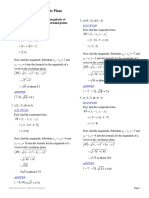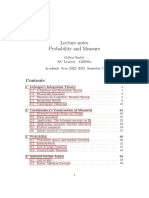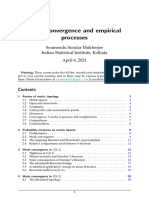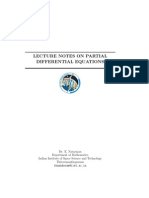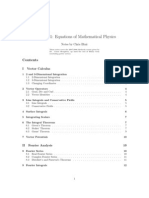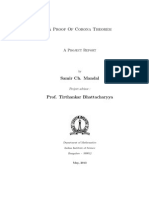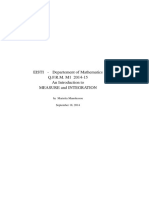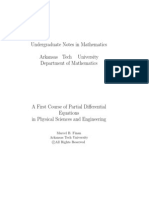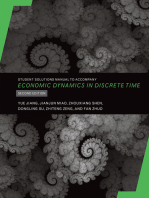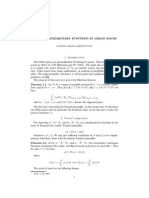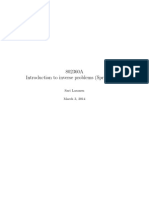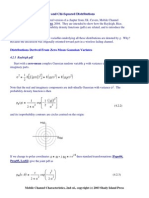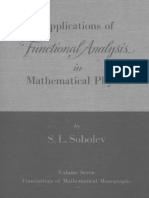A Brief Introduction To N-Functions and Orlicz Function Spaces
A Brief Introduction To N-Functions and Orlicz Function Spaces
Uploaded by
OmaguCopyright:
Available Formats
A Brief Introduction To N-Functions and Orlicz Function Spaces
A Brief Introduction To N-Functions and Orlicz Function Spaces
Uploaded by
OmaguOriginal Title
Copyright
Available Formats
Share this document
Did you find this document useful?
Is this content inappropriate?
Copyright:
Available Formats
A Brief Introduction To N-Functions and Orlicz Function Spaces
A Brief Introduction To N-Functions and Orlicz Function Spaces
Uploaded by
OmaguCopyright:
Available Formats
A brief introduction to Nfunctions and Orlicz function spaces
John Alexopoulos
Kent State University, Stark Campus
March 12, 2004
2
Contents
1 Introduction: Uniform integrability 5
1.1 Denitions . . . . . . . . . . . . . . . . . . . . . . . . . . . . . . . . . . . . . 5
1.2 The theorem of De La Vallee Poussin . . . . . . . . . . . . . . . . . . . . . . 6
1.3 The Dunford-Pettis theorem . . . . . . . . . . . . . . . . . . . . . . . . . . . 8
1.3.1 The space () . . . . . . . . . . . . . . . . . . . . . . . . . . . . . . 9
2 NFunctions 13
2.1 Denitions and elementary results . . . . . . . . . . . . . . . . . . . . . . . . 13
2.2 Conditions on Nfunctions . . . . . . . . . . . . . . . . . . . . . . . . . . . . 17
2.2.1 The
2
condition . . . . . . . . . . . . . . . . . . . . . . . . . . . . . 18
2.2.2 The
3
condition . . . . . . . . . . . . . . . . . . . . . . . . . . . . . 20
2.2.3 Some implications . . . . . . . . . . . . . . . . . . . . . . . . . . . . . 20
2.2.4 Some examples . . . . . . . . . . . . . . . . . . . . . . . . . . . . . . 22
3 Orlicz Spaces 25
3.1 Orlicz classes . . . . . . . . . . . . . . . . . . . . . . . . . . . . . . . . . . . 25
3.2 The Orlicz space L
F
. . . . . . . . . . . . . . . . . . . . . . . . . . . . . . . 27
3.2.1 The Orlicz norm . . . . . . . . . . . . . . . . . . . . . . . . . . . . . 27
3.2.2 The Luxemburg norm . . . . . . . . . . . . . . . . . . . . . . . . . . 30
3.2.3 Mean and norm convergence . . . . . . . . . . . . . . . . . . . . . . . 32
3.3 The closure of L
() in L
F
() . . . . . . . . . . . . . . . . . . . . . . . . . 33
3.4 Orlicz spaces are dual spaces . . . . . . . . . . . . . . . . . . . . . . . . . . . 36
3
4 CONTENTS
Chapter 1
Introduction: Uniform integrability
1.1 Denitions
Throughout these notes, unless stated otherwise, all measures are of bounded variation and
countably additive. In particular (, , ) will denote a probability space.
Recall that a subset / of L
1
() is called uniformly integrable if
lim
c
sup
__
[|f|c]
[f[ d : f /
_
= 0.
That is given > 0 there is a c
> 0 so that for each f / and each c c
we have
_
[|f|c]
[f [ d < .
Alternatively A subset / of L
1
() is uniformly integrable if and only if it is L
1
bounded
and for each > 0 there is a > 0 so that sup
__
A
[f [ d : f /
_
< for all A with
(A) < .
In order to establish the equivalence of the two notions above, rst note that for all measur-
able A, f /, c > 0 we have
_
A
[f[ d =
_
A[|f|<c]
[f[ d +
_
A[|f|c]
[f[ d c(A) +
_
[|f|c]
[f[ d.
Fix > 0 and choose c
0
> 0 so that sup
_
_
[|f|c]
[f[ d : f /
_
<
2
whenever c c
0
. Then
5
6 CHAPTER 1. INTRODUCTION: UNIFORM INTEGRABILITY
for all f / we have
_
[f[ d c
0
() +
_
[|f|c
0
]
[f[ d c
0
+
2
.
and thus / is L
1
bounded. Now let 0 < <
2c
0
. Then for all measurable A with (A) <
and all f / we have
_
A
[f[ d c
0
(A) +
_
[|f|c
0
]
[f[ d <
2
+
2
= .
To establish the converse, x > 0 and choose > 0 so that sup
__
A
[f[ d : f /
_
<
whenever A is measurable with (A) < . Let M = sup
__
[f[ d : f /
_
and choose
c
0
> 0 so that
M
c
0
< . Then for all f / and all c c
0
we have
([[f[ c])
1
c
_
[|f|c]
[f[ d
M
c
0
< .
So
_
[|f|c]
[f[ d < and so we are done.
1.2 The theorem of De La Vallee Poussin
One characterization of uniformly integrable sets is an old theorem that nds its roots in
Harmonic Analysis and Potential theory and it is due to De La Vallee Poussin.
Theorem 1.1 (De La Vallee Poussin) A subset / of L
1
() is uniformly integrable if and
only if there is a non-negative and convex function Q with lim
t
Q(t)
t
= so that
sup
__
Q([f[ ) d : f /
_
< .
Proof. Suppose that / is a uniformly integrable subset of L
1
(). We will construct a
non-negative and non-decreasing function q that is constant on [n, n + 1) for n = 0, 1, . . .
with lim
t
q(t) = and we will set Q(x) =
_
x
0
q(t) dt for x > 0. Use the hypothesis to
choose a subsequence (c
n
) of the positive integers so that
sup
__
[|f|cn]
[f[ d : f /
_
<
1
2
n
n = 1, 2, . . .
1.2. THE THEOREM OF DE LA VALL
EE POUSSIN 7
Then for each f / and all n = 1, 2, . . . we have
_
[|f|cn]
[f[ d =
m=cn
_
[m|f|<m+1]
[f[ d
m=cn
m([m [f[ < m + 1])
m=cn
([[f[ m]) .
So for all f / we have
n=1
m=cn
([[ f [ m]) 1 .
Now for m = 1, 2, . . . let q
m
be the number of the positive integers n, for which c
n
m.
Then q
m
. Furthermore observe that
n=1
m=cn
([[f[ m]) =
k=1
q
k
([[f[ k]) .
Let q
0
= 0 and dene q(t) = q
n
if t [n, n +1) for n = 0, 1, 2, . . . . Then if Q(x) =
_
x
0
q(t) dt
we have
_
Q([f[ ) d =
n=0
_
[n|f|<n+1]
Q([f[ ) d
n=0
_
n
m=0
q
m
_
([n [f[ < n + 1])
= q
0
([0 [f[ < 1]) + (q
0
+ q
1
) ([1 [f[ < 2]) +
=
n=0
q
n
([[f[ n])
1.
So sup
__
Q([ f [) d : f /
_
< .
8 CHAPTER 1. INTRODUCTION: UNIFORM INTEGRABILITY
To see that Q is convex, x 0 x
1
< x
2
. We then have
Q
_
1
2
(x
1
+ x
2
)
_
=
_ 1
2
(x
1
+x
2
)
0
q(t) dt
=
_
x
1
0
q(t) dt +
_ 1
2
(x
1
+x
2
)
x
1
q(t) dt
_
x
1
0
q(t) dt +
1
2
_ 1
2
(x
1
+x
2
)
x
1
q(t) dt +
1
2
_
x
2
1
2
(x
1
+x
2
)
q(t) dt
=
1
2
_
x
1
0
q(t) dt +
1
2
_
x
2
0
q(t) dt
=
1
2
(Q(x
1
) + Q(x
2
)) .
Finally observe that
Q(x) =
_
x
0
q(t) dt
_
x
x
2
q(t) dt
x
2
q(
x
2
)
and thus
Q(x)
x
1
2
q(
x
2
) as x .
We now prove the converse. Let M = sup
__
Q([f[ ) d : f /
_
. Let > 0 and choose
c
0
> 0 so that
Q(t)
t
>
M
whenever t c
0
. Then for f / and c c
0
we have that
[f[ <
M
Q([f[ ) on the set [[f[ c]. Thus
_
[|f|c]
[f[ d
M
_
[|f|c]
Q([f[ ) d
M
M =
and so we are done.
1.3 The Dunford-Pettis theorem
The well known theorem of Dunford and Pettis which states that, a subset / of L
1
() is
uniformly integrable if and only if it is relatively weakly compact, gives some deep insight
to the notion of uniform integrability. Our proof of this theorem will more or less be a
combination of those in [3] and [2].
1.3. THE DUNFORD-PETTIS THEOREM 9
1.3.1 The space ()
Dene a (pseudo)metric on the -algebra by d (A, B) = (A B) for all A, B . It is
clear that d (A, B) = (A B) = (B A) = d (B, A) and
d (A, B) + d (B, C) = (A B) + (B C)
((A B) (B C))
= (AB
c
A
c
B BC
c
B
c
C)
= (B
c
(A C) B(AC)
c
)
(B
c
(A C) B(A C))
= (A C)
= d (A, C) .
Further, the (pseudo)metric space (() , d) is a complete one, because the map A
A
is an isometry () L
1
() onto the closed set of all the characteristic functions (or more
directly, if (E
n
) is a Cauchy sequence in () then E
n
limsup E
n
= liminf E
n
, -almost
surely).
Also notice that if is an absolutely continuous measure with respect to , then is a
continuous real valued function on the (pseudo)metric space (), for if E
n
E in ()
then both (E EE
n
) 0 and (E
n
EE
n
) 0 and so
[(E
n
) (E)[ = [(E
n
) (EE
n
) + (EE
n
) (E)[
(E
n
EE
n
) + (E EE
n
) 0.
It is also noteworthy that the set-theoretic operations of union, intersection, symmetric
dierence and complementation are continuous.
Theorem 1.2 (Vitali-Hahn-Saks) Let (, , ) be a probability space and (
n
) a sequence
of -continuous measures. If lim
n
n
(E) exists for each E then
lim
(E)0
sup
n
[
n
(E)[ = 0
Proof. Fix > 0. As each
n
is continuous on (), the sets
n,m
=
_
E : [
n
(E)
m
(E)[
3
_
are closed for all positive integers n, m. Hence the sets
p
=
n,mp
n,m
are also closed for
10 CHAPTER 1. INTRODUCTION: UNIFORM INTEGRABILITY
each positive integer p. Since lim
n
n
(E) exists for each E then the complete metric
space () =
p=1
p
and thus, thanks to the Baire Category theorem, there is a positive in-
teger q such that the closed set
q
has non-empty interior. That is, there are r > 0, A
q
so that the ball B(A, r)
q
i.e. [
n
(E)
m
(E)[
3
whenever (A E) < r and
n, m q.
Now choose 0 < < r so that max
n=1,...,q
[
n
(B)[ <
3
for all B with (B) < . Notice that
if (B) < then A B, A B B (A, r). Furthermore note that B = (A B) (A B)
and so for all positive integers n and all B with (B) < we have
[
n
(B)[ [
q
(B)[ +[
n
(B)
q
(B)[
= [
q
(B)[ +[
n
(A B)
n
(A B)
q
(A B) +
q
(A B)[
[
q
(B)[ +[
n
(A B)
q
(A B)[ +[
n
(A B)
q
(A B)[
<
Now we are ready for the Dunford-Pettis theorem:
Theorem 1.3 (Dunford-Pettis) A subset / of L
1
() is uniformly integrable if and only
if it is relatively weakly compact.
Proof. (=): Suppose that / L
1
() is uniformly integrable. Let /
weak*
(L
())
= (L
1
())
. For simplicity set (
E
) (E) for all E . Notice that
can be viewed as a nitely additive set function on . As /
weak*
we have that
[(E)[ sup
fK
_
E
fd
sup
fK
_
E
[f[ d
and so is -continuous (hence countably additive as well), thanks to /s uniform integrabil-
ity. Thus by the Radon-Nikodym Theorem, (E) =
_
E
d
d
d for all E . Passing to simple
functions as well as an elementary density argument, convinces as that (g) =
_
g
d
d
d for
all g L
(). Consequently L
1
() and so, by a simple comparison of topologies,
/
weak*
and /
weak
are equal and topologically identical. Hence /
weak
is (weakly) compact
thanks to Alaoglous theorem.
1.3. THE DUNFORD-PETTIS THEOREM 11
(=): Now assume that / is relatively weakly compact and suppose that / is not uniformly
integrable. Then there is an exceptional
0
> 0, a sequence (f
n
) / and a sequence (E
n
)
of measurable sets with (E
n
) 0 such that
_
En
f
n
d
0
for all positive integers n. As
/ is relatively weakly compact, the Eberlein-Smulian theorem guarantees the existence of a
subsequence (n
k
) of the positive integers and that of a
function f L
1
() so that f
n
k
weakly
f. For each k and each E , set
k
(E) =
_
E
f
n
k
d and notice that lim
k
k
(E) =
_
E
fd. Hence by the Vitali-Hahn-Saks theorem
lim
j
sup
k
k
_
E
n
j
_
= 0. In particular lim
j
j
_
E
n
j
_
_
En
j
f
n
j
d
= 0 contradicting the fact
that
_
En
f
n
d
0
for all positive integers n.
12 CHAPTER 1. INTRODUCTION: UNIFORM INTEGRABILITY
Chapter 2
NFunctions
2.1 Denitions and elementary results
In this section we will summarize the necessary facts about a special class of convex functions
called Nfunctions. For a detailed account of these facts, the reader could consult [4] or [5].
Denition 2.1 Let f : [0, ) [0, ) be a right continuous, monotone increasing function
with
1. f(0) = 0;
2. lim
t
f(t) = ;
3. f(t) > 0 whenever t > 0;
then the function dened by
F(x) =
_
|x|
0
f(t) dt
is called an Nfunction. Alternatively, the function F is an Nfunction if and only if F is
continuous, even and convex with
1. lim
x0
F(x)
x
= 0
2. lim
x
F(x)
x
=
3. F(x) > 0 if x > 0.
13
14 CHAPTER 2. NFUNCTIONS
In that case if f = F
+
, the right derivative of F then f satises f(0) = 0; lim
t
f(t) = ;
f(t) > 0 whenever t > 0; and F(x) =
_
|x|
0
f(t) dt.
It is not hard to see that the composition of two Nfunctions is an Nfunction. A little
more thought convinces us about the truth of the converse. i.e. every Nfunction F is the
composition of two other Nfunctions. That is, there are Nfunctions F
1
and F
2
so that
F = F
2
F
1
. Here is why:
Given the Nfunction F
1
then F
2
is uniquely determined by F
2
= F F
1
1
. Since for x > 0
we have that f
2
(x) =
f(F
1
1
(x))
f
1
(F
1
1
(x))
and F
1
1
is increasing, tends to zero as x 0 and to innity
as x it is necessary and sucient for F
2
to be an Nfunction if
f
f
1
satises all the
conditions that right derivatives of Nfunctions satisfy. Take f
1
= f
p
for any 0 < p < 1 and
the rest follows.
Nfunctions come in mutually complementary pairs. In fact we have the following
Denition 2.2 For an Nfunction F dene
G(x) =
_
x
0
g(t) dt
where g is the right inverse of the right derivative f of F (see gure 2.1). G is an Nfunction
called the complement of F. Furthermore it is plain that the complement of G is F.
Figure 2.1: A pair of complementary N-functions
2.1. DEFINITIONS AND ELEMENTARY RESULTS 15
Complementary pairs of N-functions satisfy,
Theorem 2.1 (Youngs Inequality) If F and G are two mutually complementary N-functions
then
uv F(u) + G(v) u, v R
Figure 2.2: A geometric interpretation of Youngs Inequality.
Figure 2.2 above, makes Youngs Inequality geometrically clear. It is also clear from the
gure that equality is attained when v = f([u[)sgn u or u = g([v[)sgn v. In particular we
have
[u[f([u[) = F(u) + G(f([u[))
and
[v[g([v[) = F(g([v[)) + G(v).
Consequently we have an alternative denition for the complementary function G:
G(x) = maxt[x[ F(t) : t 0
Youngs Inequality gives rise to the following
Theorem 2.2 Suppose that F
1
, F
2
are Nfunctions with complements G
1
and G
2
respec-
tively. Suppose that F
1
(x) F
2
(x) for x x
0
. Then G
2
(y) G
1
(y) for y y
0
= f
2
(x
0
) =
F
2+
(x
0
).
16 CHAPTER 2. NFUNCTIONS
Proof. Let f
1
, f
2
, g
1
and g
2
be the right derivatives of F
1
, F
2
, G
1
and G
2
respectively.
Then g
2
(y) x
0
whenever y y
0
= f
2
(x
0
). Note that yg
2
(y) = G
2
(y) + F
2
(g
2
(y)) (equality
case of Youngs Inequality). Furthermore by Youngs Inequality yg
2
(y) G
1
(y) +F
1
(g
2
(y))
and so G
2
(y) + F
2
(g
2
(y)) G
1
(y) + F
1
(g
2
(y). But since F
1
(g
2
(y) F
2
(g
2
(y)) we have that
G
2
(y) G
1
(y).
N-functions grow at dierent rates. The following denition makes their comparison possible.
Denition 2.3 For N-functions F
1
, F
2
we write F
1
F
2
if there is a K > 0 so that F
1
(x)
F
2
(Kx) for large values of x. If F
1
F
2
and F
2
F
1
then we say that F
1
and F
2
are
equivalent and we write F
1
F
2
.
If two N-functions are comparable then so are their complements in the reverse. Indeed if
F
1
F
2
then G
2
G
1
, where G
i
is the complement of F
i
. In particular if F
1
(x) F
2
(x)
for large values of x then G
2
(x) G
1
(x) for large values of x.
It is worth noting at this stage that every Nfunction F is equivalent to the Nfunction
dened by (x) =
_
x
0
F(t)
t
dt. After all
(x) =
_
x
0
F(t)
t
dt
_
x
0
tf(t)
t
dt = F(x).
Furthermore
F(t)
t
=
1
t
_
t
0
f(s) ds
1
t
_
t
t
2
f(s) ds
1
2
f
_
t
2
_
and so
(2x) =
_
2x
0
F(t)
t
dt
1
2
_
2x
0
f
_
t
2
_
dt =
_
x
0
f(s) ds = F(x)
Now the convexity of F ensures that F(x) F(x) for 0 < < 1 and so
F(t)
t
is increasing.
A convex function Q is called the principal part of an N-function F, if F(x) = Q(x) for
large x. All convex functions of the De La Vallee Poussin type are principal parts of
N-functions. Specically we have
Theorem 2.3 If Q is convex with lim
x
Q(x)
x
= then Q is the principal part of some
N-function.
Proof. Since lim
x
Q(x)
x
= then lim
x
Q(x) = and so there is x
0
so that Q(x) > 0
for x x
0
. Thus Q(x) Q(x
0
) =
_
x
x
0
q(t) dt where q is the right derivative of Q. Of course
2.2. CONDITIONS ON NFUNCTIONS 17
q is nondecreasing and rightcontinuous. Furthermore lim
t
q(t) = since otherwise
q(t) b would imply Q(x) b(xx
0
) +q(x
0
) contradicting the fact that lim
x
Q(x)
x
= .
Without loss of generality assume that q(t) > 0 for t x
0
. Now since lim
t
q(t) =
there is x
1
x
0
+ 1 so that q(x
1
) > q(x
0
+ 1) + Q(x
0
). Then
Q(x
1
) =
_
x
0
+1
x
0
q(t) dt +
_
x
1
x
0
+1
q(t) dt + Q(x
0
)
q(x
0
+ 1) + Q(x
0
) + q(x
1
)(x
1
x
0
1)
< q(x
1
)(x
1
x
0
)
and thus =
x
1
q(x
1
)
Q(x
1
)
> 1. Now dene F by
F(x) =
_
_
_
Q(x
1
)
x
1
[x[
for [x[ x
1
Q(x) for [x[ x
1
Now F is an Nfunction since its right derivative
f(x) = F
+
(x) =
_
_
_
Q(x
1
)
x
1
[x[
1
for 0 [x[ x
1
q(x) for [x[ x
1
is right continuous for x 0 satisfying f(0) = 0, lim
t
f(t) = and f(t) > 0 whenever
t > 0.
2.2 Conditions on Nfunctions
There are several important classes of N-functions. Among other things, these conditions
relate to the growth of N-functions. Here are some of the most important denitions:
Denition 2.4 Let F be an N-function and let G denote its complement. Then
1. F is said to satisfy the
2
condition (F
2
) if
limsup
x
F(2x)
F(x)
< . That is, there is a K > 0 so that F(2x) KF(x) for large
values of x. If G
2
we say that F
2
.
2. F is said to satisfy the
condition (F
) if there is a K > 0 so that F(xy)
KF(x)F(y) for large values of x and y. If G
we say that F
.
18 CHAPTER 2. NFUNCTIONS
3. F is said to satisfy the
3
condition (F
3
) if there is a K > 0 so that xF(x)
F(Kx) for large values of x. If G
3
we say that F
3
.
4. F is said to satisfy the
2
condition (F
2
) if there is a K > 0 so that (F(x))
2
F(Kx) for large values of x. If G
2
we say that F
2
.
It is plain that all the classes dened above are closed under the equivalence of Nfunctions.
2.2.1 The
2
condition
Among all these conditions, the
2
condition is perhaps the most important. It is worth
noting that F
2
is equivalent to F(cx) k
c
F(x) for large values of x, where c can be any
number greater than 1. Indeed for 2
n
c and large enough x we have F(cx) F(2
n
x)
K
n
F(x) = k
c
F(x). Conversely, if 2 c
n
we have F(2x) F(c
n
x) k
n
c
F(x) for large values
of x.
N-functions that satisfy the
2
condition have growth rates less than that of power functions
as we can see by the following theorem:
Theorem 2.4 If F
2
then there are constants > 1 and c > 0 so that F(x) c[x[
for
large values of x.
The proof of this theorem follows easily from the following independently useful lemma:
Lemma 2.5 F
2
i there are constants > 1 and x
0
so that
xf(x)
F(x)
< for all x x
0
where f is the right derivative of F.
Proof. First note that
kF(x) F(2x) =
_
2x
0
f(t) dt >
_
2x
x
f(t) dt > xf(x) for large enough x
and so necessity follows.
To see the converse, observe that since xf(x) > F(x) for all x, > 1. Now for x x
0
we
have that
_
2x
x
f(t)
F(t)
dt <
_
2x
x
1
t
dt = log 2.
2.2. CONDITIONS ON NFUNCTIONS 19
Hence
log
F(2x)
F(x)
=
_
F(2x)
F(x)
1
t
dt < log 2
and so F(2x) < 2
F(x).
Now the proof of the theorem follows from the fact that
_
x
x
0
f(t)
F(t)
dt <
_
x
x
0
1
t
dt for all x > x
0
i.e. that F(x) <
F(x
0
)
x
0
x
.
Lemma 2.5 oers a test for the
2
condition. It is often useful to have a direct test to
determine when the complement of an Nfunction satises the
2
condition (i.e. when does
an Nfunction belong to
2
). The following theorem oers such a test:
Theorem 2.6 G
2
i there exist constants > 1 and x
0
0 such that
G(x)
1
2
G(x) for all x x
0
.
Lets rst isolate the following useful lemma:
Lemma 2.7 If F
1
(x) = aF(bx) where a and b are positive then the complement G
1
of F
1
is
given by G
1
(x) = aG
_
x
ab
_
, where G is the complement of F.
Proof. Notice that the right derivative f
1
of F
1
is given by f
1
(t) = abf(bt) where f is the
right derivative of F. Then the right derivative g
1
of G
1
is given by g
1
(s) =
1
b
g
_
s
ab
_
, where
g is the right derivative of G. So
G
1
(x) =
_
|x|
0
g
1
(s) ds =
1
b
_
|x|
0
g
_
s
ab
_
ds = a
_ |x|
ab
0
g(r)dr = aG
_
x
ab
_
which is what we wanted.
Proof of theorem 2.6. First suppose that G
2
. Then F, the complement of G, satises
the
2
condition and thus there is a constant k > 2 so that F(2x) kF(x) for large values
of x. So in virtue of the previous lemma and theorem 2.2, kG(x/k) G(x/2) or equivalently
kG(x) G
_
kx
2
_
for large values of x. So the forward implication follows by setting =
k
2
.
The reverse implication is also a direct consequence of the lemma and theorem 2.2 and its
proof is left as an exercise.
20 CHAPTER 2. NFUNCTIONS
2.2.2 The
3
condition
First note that if F
3
then F increases more rapidly than any power function. Indeed
for any positive integer n and x k
n
x
0
we have:
F(x) >
x
k
F
_
x
k
_
>
x
2
k
3
F
_
x
k
2
_
> >
x
n
k
n(n+1)
2
F
_
x
k
n
_
>
F(x
0
)x
n
k
n(n+1)
2
Functions satisfying the
3
condition are equivalent to their integrals. In particular we have
that if (x) =
_
x
0
F(t) dt and F
3
then F. In order to see this rst observe that
(x) =
_
x
0
F(t) dt < xF(x) F(kx), for suciently large x. Furthermore for x > 1 we have
(2x) =
_
2x
0
F(t) dt
_
2x
x
F(t) dt > xF(x) > F(x).
From this we obtain the following theorem:
Theorem 2.8 If F
3
and G denotes the complement of F then there are constants
k
1
< k
2
so that
k
1
xF
1
(k
1
x) G(x) k
2
xF
1
(k
2
x)
for large values of x.
Proof. Let (x) =
_
x
0
F(t) dt and (x) =
_
x
0
F
1
(t) dt. Then and are complementary
and as F we conclude G. Now note that
(x) =
_
x
0
F
1
(t) dt < xF
1
(x)
while
(x) =
_
x
0
F
1
(t) dt >
_
x
x
2
F
1
(t) dt >
x
2
F
1
_
x
2
_
.
Since G the result follows.
2.2.3 Some implications
There is a plethora of results pertaining to the dierent conditions on Nfunctions. Again the
reader should consult [4] and [5] for a detailed account of the subject. Next, we summarize
some of the most important relations between the dierent classes of Nfunctions:
2.2. CONDITIONS ON NFUNCTIONS 21
Theorem 2.9 Let F be an N-function and let G be its complement; then the following hold.
1. If F
then F
2
.
2. IF F
2
then F
3
.
3. If F
3
then its complement G
2
(i.e. F
2
).
4. If F
2
then its complement G
(i.e. F
).
Proof. (1) and (2) are obvious. For (3) let k
1
and k
2
as in theorem 2.8. Then since F
1
is
concave and
2k
2
k
1
> 1 we have
F
1
_
2k
2
k
1
x
_
<
2k
2
k
1
F
1
(x).
Thus by theorem 2.8 we obtain
G(2x) 2k
2
xF
1
(2k
2
x) < 2k
2
x
2k
2
k
1
F
1
(k
1
x)
_
2k
2
k
1
_
2
G(x)
for large values of x.
We continue into showing (4): So assume F(kx) F
2
(x) for large values of x. Then for
suciently large x and y with x y we have F(kxy) > F(kx) F
2
(x) F(x)F(y). By
setting x = F
1
(u) and y = F
1
(v) we have F(kF
1
(u)F
1
(v) > uv and thus
F
1
(uv) kF
1
(u)F
1
(v) for large u, v
Now since F
2
then F
3
and so by theorem 2.8 we have that k
1
xF
1
(k
1
x) G(x)
k
2
xF
1
(k
2
x) for large values of x. So for suciently large u and v we get
G(uv) k
2
uvF
1
(k
2
uv)
= (
_
k
2
u)(
_
k
2
v)F
1
(
_
k
2
u
_
k
2
v)
k
_
k
2
uF
1
(
_
k
2
u)
_
k
2
vF
1
(
_
k
2
v)
kG
_
k
2
k
1
u
_
G
_
k
2
k
1
v
_
.
Since G
2
the result follows.
Last and not least we prove the following theorem:
22 CHAPTER 2. NFUNCTIONS
Theorem 2.10 Given an N-function F, there is an N-function H
2
, and thus H
,
so that H (H(x)) F(x) for large values of x.
Proof. Write F = F
1
F
2
, where F
1
, F
2
are N-functions and let G
i
be the complement of
F
i
. Let Q(x) = e
G
1
(x)+G
2
(x)
. The function Q is convex, with lim
x
Q(x)
x
= . Hence there
is an N-function K whose principal part is Q. Clearly K
2
and G
i
(x) K(x) for large
x. So if H is complementary to K, we must have H
and H(x) F
i
(x) for large x.
Thus H (H(x)) F
1
(F
2
(x)) = F(x) for large values of x.
2.2.4 Some examples
In the next example we construct a pair of complementary Nfunctions neither of which
satises the
2
condition, yet both grow slower than a power of x.
Example 2.1 Let f be dened by
f(t) =
_
_
_
t if 0 t < 1
k! if (k 1)! t < k! k = 2, 3, . . .
Clearly F(x) =
_
x
0
f(t) dt is an Nfunction. Furthermore for each n let x
n
= n!. Then
F(2x
n
) =
_
2n!
0
f(t) dt >
_
2n!
n!
f(t) dt = (n + 1)! n!
while
F(x
n
) =
_
n!
0
f(t) dt < n! n!
So
F(2xn)
F(xn)
>
(n+1)!n!
n!n!
= n + 1 and thus limsup
x
F(2x)
F(x)
= . Hence F ,
2
.
Now observe that if g is the right inverse of f then
g(t) =
_
_
_
t if 0 t < 1
(k 1)! if (k 1)! t < k! k = 2, 3, . . .
So the complement G of F is given by G(x) =
_
x
0
g(t) dt. Again let x
n
= n! and note that
G(2x
n
) =
_
2n!
0
g(t) dt >
_
2n!
n!
g(t) dt = n! n!
2.2. CONDITIONS ON NFUNCTIONS 23
while
G(x
n
) =
_
n!
0
g(t) dt < (n 1)! n!
So
G(2xn)
G(xn)
>
n!n!
(n1)!n!
= n and thus limsup
x
G(2x)
G(x)
= . Hence G ,
2
.
Now it is plain to see that f(t) < t
2
and g(t) < t for large values of t. Hence F and G grow
slower than x
3
and x
2
respectively.
We have seen that every Nfunction F satisfying the
3
condition grows faster than all
power functions. The next example shows that the converse is not true even if F satises
the
2
condition.
Example 2.2 Let F be an Nfunction whose principal part is given by x
log x
. It is plain
that F grows faster than any power function. Furthermore for large values of x we have that
1
4
F(2x) =
1
4
(2x)
log 2x
x
log 2x
> x
log x
= F(x)
and so F
2
by theorem 2.6.
Now notice that for any positive k and p we have that k
log kx
=
_
k
log kx
log k
_
log k
= (kx)
log k
and
so
k
log kx
= (kx)
log k
log kx
< x
p
for large values of x. Similarly x
log kx
= x
log k
x
log x
and thus
x
log kx
< x
p
x
log x
log kx
< x
p
x
log x
for large values of x.
F(kx)
xF(x)
=
(kx)
log kx
xx
log x
<
x
2p
x
for large values of x.
Thus lim
x
F(kx)
xF(x)
= 0 for all positive constants k. Hence F ,
3
.
Next we give an example of an Nfunction F in
2
.
Example 2.3 Let F(x) =
x
2
log(|x|+e)
. It is a matter of calculus to show that F is an N
function. The reader can also verify that lim
x
F(2x)
F(x)
= 4 and lim
x
F(x
2
)
F
2
(x)
= . Hence
F
2
but F ,
.
24 CHAPTER 2. NFUNCTIONS
Finally we give an example of an Nfunction F in
3
2
.
Example 2.4 An Nfunction F whose principal part is x
log x
is in
3
but not in
2
. The
details are left to the reader.
Chapter 3
Orlicz Spaces
3.1 Orlicz classes
In this section we summarize the necessary denitions and results about Orlicz classes.
Again, for a detailed account the reader should consult [4] or [5]. Throughout the remaining
material we are going to assume that we are working with a nonatomic probability space
(, , ).
Denition 3.1 For an N-function F and a measurable u dene
F(u) =
_
F(u)d.
Let
L
F
= u measurable : F(u) < . The set
L
F
is called an Orlicz class.
The theorem of De La Vallee Poussin establishes that every relatively weakly compact subset
of L
1
is a bounded subset of some Orlicz class. It also establishes the fact that L
1
is the union
of all Orlicz classes. But it does not specify just how well the function F can be chosen. We
begin by noting the following improvement to De La Vallee Poussins theorem (see [1]):
Theorem 3.1 A subset / of L
1
() is uniformly integrable if and only if there exists an
Nfunction H
2
so that H(/) = H([ u [) : u / is uniformly integrable.
Proof. By the theorem of De La Vallee Poussin there is a non-negative and convex function
Q with lim
t
Q(t)
t
= so that sup
__
Q([ u [) d : u /
_
< . Since Q is the principal
25
26 CHAPTER 3. ORLICZ SPACES
part of some Nfunction there is no loss in assuming that Q is actually an Nfunction.
By theorem 2.10 there is an Nfunction H
2
so that H(H(x)) Q(x) for large values
of x. Hence sup
__
H(H([ u [)) d : u /
_
< and so H(/) = H([ u [) : u / is
uniformly integrable by De La Vallee Poussins theorem. The converse is just De La Vallee
Poussins theorem again.
The famous Jensens inequality, proved in almost every text in analysis or probability theory,
is often a tool of great value:
Theorem 3.2 (Jensens inequality) For convex and u measurable we have
_
1
(A)
_
A
ud
_
1
(A)
_
A
(u) d
for all A with (A) > 0.
Theorem 3.3 Let F
1
and F
2
be Nfunctions. Then
L
F
1
L
F
2
if and only if there positive
constants c and x
0
so that F
2
(x) cF
1
(x) for all x x
0
.
Proof. In order to see the suciency let u
L
F
1
. Then
F
2
(u) =
_
F
2
(u) d =
_
[|u|<x
0
]
F
2
(u)d +
_
[|u|x
0
]
F
2
(u) d F
2
(x
0
) + c
_
F
1
(u) d <
and so u
L
F
2
.
In order to establish the converse, suppose that there is a sequence (x
n
) with x
n
so
that F
2
(x
n
) > 2
n
F
1
(x
n
). Since (, , ) is nonatomic, choose a sequence (E
n
) of pairwise
disjoint sets with (E
n
) =
F
1
(x
1
)
2
n
F
1
(xn)
and let u =
n=1
x
n
En
. Then u
L
F
1
since
_
F
1
(u) d =
n=1
F
1
(x
n
)(E
n
) =
n=1
F
1
(x
n
)
F
1
(x
1
)
2
n
F
1
(x
n
)
=
n=1
F
1
(x
1
)
2
n
< F
1
(x
1
) <
But u ,
L
F
2
since
_
F
2
(u) d =
n=1
F
2
(x
n
)(E
n
)
n=1
2
n
F
1
(x
n
)
F
1
(x
1
)
2
n
F
1
(x
n
)
=
n=1
F
1
(x
1
) =
Hence the result is established.
It is plain that each Orlicz class
L
F
is an absolutely convex set. In general,
L
F
is not a
linear space. Our next result establishes exactly when this is so.
3.2. THE ORLICZ SPACE L
F
27
Theorem 3.4
L
F
is a linear space if and only if F
2
.
Proof. If F
2
then for each scalar c there is a constant k
c
and x
c
> 0 so that F(cx)
k
c
F(x) for all x x
c
. So for any u
L
F
we have
F(cu) =
_
F(cu) d =
_
[|u|<xc]
F(cu) d +
_
[|u|xc]
F(cu) d F(cx
c
) + k
c
_
F(u) d <
and so cu
L
F
. For closure under addition, let u
1
, u
2
L
F
, set u =
1
2
(u
1
+ u
2
) and notice
that
F(u
1
+ u
2
) =
_
F(u
1
+ u
2
) d
=
_
F(2u) d
=
_
[|u|<x
2
]
F(2u) d +
_
[|u|x
2
]
F(2u) d
F(2x
2
) + k
2
_
F(u) d
= F(2x
2
) + k
2
_
F(
1
2
(u
1
+ u
2
)) d
F(2x
2
) +
k
2
2
F(u
1
) +
k
2
2
F(u
2
) <
and so u
1
+ u
2
L
F
.
Now assume that
L
F
is a linear space. Let (x) = F(2x). Note that for u
L
F
we have
that 2u
L
F
and thus u
L
. Hence, by theorem 3.3 we have that there is a constant
k > 0 so that (x) = F(2x) kF(x) for large values of x. That is F
2
.
3.2 The Orlicz space L
F
3.2.1 The Orlicz norm
Given an Nfunction F and its complement G, let
L
F
=
_
u measurable :
_
uv d < for all v
L
G
_
It is plain that L
F
is a vector space. Furthermore, Youngs inequality ensures that
L
F
L
F
.
28 CHAPTER 3. ORLICZ SPACES
Theorem 3.5 For each u L
F
we have
sup
G(v)1
uv d
<
Proof. Assume not. Then without loss of generality there is a nonnegative u L
F
and a
sequence of nonnegative (v
n
) in
L
G
with G(v
n
) 1 so that
_
uv
n
d > 2
n
Let v =
n=1
1
2
n
v
n
. Then by the convexity of G we have that G(v) 1, yet
_
uv d = .
Now dene the Orlicz norm of u L
F
by
|u|
F
= sup
G(v)1
uv d
It is very easy to see that all the axioms for a norm are satised. Equipped with this norm
L
F
is called an Orlicz space. An obvious but important property of the norm is that is that
|u
1
|
F
|u
2
|
F
whenever u
1
u
2
a.s. We leave it as an exercise to the reader to verify that
the Orlicz norm is complete, thus making an Orlicz space a Banach space.
Example 3.1 (The Orlicz norm of a characteristic function) Notice that if E
and v
L
G
with G(v) 1 then by Jensens inequality we have
G
_
1
(E)
_
E
v d
_
1
(E)
_
E
G(v) d
1
(E)
and so
|
E
|
F
= sup
G(v)1
E
v d
(E)G
1
_
1
(E)
_
.
On the other hand if v
0
= G
1
_
1
(E)
_
E
then G(v
0
) = 1 and
_
E
v
0
d = (E)G
1
_
1
(E)
_
.
So
|
E
|
F
= (E)G
1
_
1
(E)
_
.
Example 3.2 (The classical L
p
spaces) Let p, q be numbers greater than one and such
that
1
p
+
1
q
= 1. If the Nfunction F is given by F(x) =
|x|
p
p
then the complement G of F is
3.2. THE ORLICZ SPACE L
F
29
given by G(x) =
|x|
q
q
. For u L
F
with |f|
p
= 1 and v
L
G
with G(v) 1, the classical
Holders inequality yields
uv d
|u|
p
|v|
q
q
1
q
.
On the other hand if v
0
= q
1
q
[u[
p1
sgn u then G(v
0
) = 1,
_
uv
0
d = q
1
q
and so
|u|
F
= q
1
q
So for any u L
F
we have
|u|
F
= q
1
q
|u|
p
.
Our next goal is to derive a generalized Holders inequality. We will need several lemmas
which will be useful in other occasions.
Lemma 3.6 For every u L
F
and v
L
G
with G(v) > 1 we have
uv d
|u|
F
G(v)
Proof. Notice that G
_
v
G(v)
_
1
G(v)
G(v). Hence
_
G
_
v
G(v)
_
d
1
G(v)
_
G(v) d = 1
Thus
_
u
v
G(v)
d |f|
F
and so the result follows.
Lemma 3.7 Let F be an Nfunction and let f be its right derivative. Let u L
F
with
|u|
F
1. Then v = f([u[)
L
G
and G(v) 1.
Proof. Suppose that G(v) > 1. Then there is a positive integer n so that if u
n
= u
[|u|n]
we have that
_
G(f([u
n
[)) d > 1
Hence
G(f([u
n
[)) < F(u
n
) + G(f([u
n
[)) = [u
n
[ f([u
n
[)
30 CHAPTER 3. ORLICZ SPACES
thanks to the equality case of Youngs inequality. So by integrating the last inequality and
using the previous lemma we obtain
_
G(f([u
n
[)) d <
_
[u
n
[ f([u
n
[) d |u
n
|
F
_
G(f([u
n
[)) d
and so |u|
F
|u
n
|
F
> 1 which is obviously a contradiction.
Lemma 3.8 Let u L
F
with |u|
F
1. Then u
L
F
and
F(u) |u|
F
Consequently for every u L
F
we have
F
_
u
|u|
F
_
1
Proof. Set v = f([u[)sgn u. Then by the previous lemma we have G(v) 1. By the
equality case of Youngs inequality once again we have uv = F(u) + G(v) and so
_
F(u) d
_
F(u) d +
_
G(v) d =
_
uv d |u|
F
Now the second conclusion of the lemma is obvious.
Theorem 3.9 (Holders inequality) For every u L
F
and v L
G
we have
uv d
|u|
F
|v|
G
Proof. From the previous lemma we have that
F
_
u
|u|
F
_
1
Hence
u
|u|
F
v d
|v|
G
.
3.2.2 The Luxemburg norm
Denition 3.2 In light of lemma 3.8, given an Nfunction F, the set B
(F)
= u measurable : F(u)
1 is an absolutely convex, balanced and absorbing set within its corresponding Orlicz space
3.2. THE ORLICZ SPACE L
F
31
L
F
. The well known Minkowski functional denes a dierent norm | |
(F)
on L
F
which is
called the Luxemburg norm. Specically for u L
F
set
|u|
(F)
= inf
_
k > 0 : F
_
u
k
_
1
_
.
It is plain from lemma 3.8 that |u|
(F)
|u|
F
. Furthermore the inmum is attained when-
ever u L
F
is not 0 a.s. and we have
F
_
u
|u|
(F)
_
1.
The reader can verify these facts through the use of Fatous lemma or the monotone conver-
gence theorem.
Example 3.3 (The Luxemburg norm of a characteristic function) Let E with
(E) > 0. Then F
_
F
1
_
1
(E)
_
E
_
= 1 and so
|
E
|
(F)
=
1
F
1
_
1
(E)
_
Theorem 3.10 The unitball of the Orlicz space L
F
endowed with the Luxemburg norm is
B
(F)
= u measurable : F(u) 1. Furthermore for any u
L
F
we have that
_
_
_
F(u) |u|
(F)
whenever |u|
(F)
1
F(u) |u|
(F)
whenever |u|
(F)
> 1
Proof. If |u|
(F)
1 then
1
|u|
(F)
_
F(u) d
_
F
_
u
|u|
(F)
_
d 1
and so F(u) |u|
(F)
. On the other hand, if |u|
(F)
> 1 then for small enough we have
1
|u|
(F)
F(u) d
_
F
_
u
|u|
(F)
_
d > 1
hence F(u) |u|
(F)
.
We have noted that the Orlicz norm is larger than the Luxemburg norm. In fact these norms
are equivalent as established by the following theorem.
Theorem 3.11 For any u L
F
we have |u|
(F)
|u|
F
2|u|
(F)
.
32 CHAPTER 3. ORLICZ SPACES
Proof. The rst inequality is already established. In order to see the second inequality,
note that from Youngs inequality we have that
|u|
F
= sup
G(v)1
_
uv d F(u) + 1
whenever u
L
F
. Thus
_
_
_
_
u
|u|
(F)
_
_
_
_
F
F
_
u
|u|
(F)
_
d + 1 2
and so the second inequality is done.
At this stage notice that theorem 3.10 gives an alternative formula for the Orlicz norm:
sup
v
(G)
1
uv d
from which we can easily obtain the following stronger versions of Holders inequality:
Theorem 3.12 (Holders inequality) For every u L
F
and v L
G
we have
uv d
|u|
(F)
|v|
G
and For every u L
F
and v L
G
we have
uv d
|u|
F
|v|
(G)
3.2.3 Mean and norm convergence
Denition 3.3 We say that a sequence of functions (u
n
) in L
F
converges in mean to a
function u L
F
i F(u
n
u) 0 as n .
In view of lemma 3.8, it is plain that norm convergence implies mean convergence. If F
2
then we have the following theorem:
Theorem 3.13 If F(u
n
u) 0 as n for F
2
then |u
n
u|
F
0 as n .
Proof. Fix > 0 and choose a positive integer k so that
1
2
k1
< . Since F
2
and
lim
n
F(u
n
u) = 0, we have that lim
n
F(2
k
(u
n
u)) = 0 and thus there is a positive
3.3. THE CLOSURE OF L
() IN L
F
() 33
integer N so that F(2
k
(u
n
u)) < 1 whenever n N. Thus for n N
_
_
2
k
(u
n
u)
_
_
F
= sup
G(v)1
2
k
(u
n
u) v d
sup
G(v)1
_
2
k
(u
n
u)
[v[ d
sup
G(v)1
_
F(2
k
(u
n
u)) +G(v)
(by Youngs inequality)
< 2
Hence |u
n
u|
F
<
1
2
k1
< and the result is established.
Remark 3.1 If F /
2
, choose an increasing sequence of numbers (a
n
) with F (2a
n
) >
2
n
F (a
n
) and F (a
1
) > 1.Since (, , ) is non-atomic, for each n choose pairwise disjoint
sets A
n
1
, . . . , A
n
n
with (A
n
k
) =
1
n2
k
F(a
k
)
and let u
n
=
n
k=1
a
k
A
n
k
. Then
F(u
n
) =
n
k=1
F (a
k
) (A
n
k
) <
1
n
Hence (u
n
) converges to zero in mean. On the other hand, (u
n
) does not converge to zero in
norm: For otherwise |u
n
|
F
0 implies |2u
n
|
F
0 and so F(2u
n
) 0. But
F(2u
n
) =
n
k=1
F (2a
k
) (A
n
k
) >
n
k=1
2
k
F (a
k
)
1
n2
k
F (a
k
)
= 1
which is obviously a contradiction.
3.3 The closure of L
() in L
F
()
Notation 3.1 Let E
F
denote the closure of L
() in the Orlicz space L
F
().
Note that if u
L
F
then the sequence of bounded functions
_
u
[|u|n]
_
converges to u in
mean. Indeed
F(u
[|u|n]
u) =
_
F
_
u
[|u|n]
u
_
d
=
_
[|u|n]
F
_
u
[|u|n]
u
_
d +
_
[|u|>n]
F (u) d
=
_
[|u|>n]
F (u) d 0 as n
34 CHAPTER 3. ORLICZ SPACES
In light of theorems 3.4 and 3.13 we have the following
Proposition 3.14 If F
2
then E
F
= L
F
.
In general we have that E
F
L
F
for if u E
F
choose a bounded function r with |u r|
F
<
1
2
. Then |2u 2r|
F
< 1 and so by lemma 3.8 we have 2u 2r
L
F
and F(2u 2r)
2 |u r|
F
< 1. As 2r
L
F
, convexity ensures that u =
1
2
[(2u 2r) + 2r]
L
F
.
Theorem 3.15 The space E
F
[0, 1] is separable.
Proof. First note that if u is a bounded function with |u|
= M then by Lousins theorem,
there is a sequence of continuous functions (u
n
) with |u
n
|
M and a sequence of sets
(A
n
) with (A
n
) <
1
n
so that u u
n
= 0 on [0, 1] A
n
. Thus
|u
n
u|
F
= sup
G(v)1
_
1
0
[u
n
u[ [v[ d = sup
G(v)1
_
An
[u
n
u[ [v[ d
2M sup
G(v)1
_
An
[v[ d = 2M|
An
|
F
= 2M(A
n
) G
1
_
1
(A
n
)
_
0 as n .
Now separability follows from the fact that every continuous function is the uniform limit of
polynomials with rational coecients.
Denition 3.4 We say that a function u L
F
has absolutely continuous norm if and only
if > 0 there is > 0 such that |u
A
|
F
< for any measurable set A with (A) < .
Theorem 3.16 A function u L
F
has absolutely continuous norm if and only if u E
F
.
Proof. Suppose that u L
F
has absolutely continuous norm. Since u L
1
then ([[u[ > n])
0 as n and thus
_
_
u u
[|u|n]
_
_
F
=
_
_
u
[|u|>n]
_
_
F
0 as n . As each of the func-
tions u
[|u|n]
is bounded, the forward direction is established.
Now suppose that u E
F
. Fix > 0 and choose a bounded function r with |u r|
F
<
2
.
Let M = |r|
and choose > 0 such that xG
1
_
1
x
_
<
2M
, whenever 0 < [x[ < (after
all lim
x0
xG
1
_
1
x
_
= 0). Now for any measurable set A with (A) < we have |
A
|
F
=
(A) G
1
_
1
(A)
_
<
2M
thanks to example 3.1. Thus
|u
A
|
F
|(u r)
A
|
F
+|r
A
|
F
|u r|
F
+ M|
A
|
F
<
2
+
2
=
3.3. THE CLOSURE OF L
() IN L
F
() 35
and so we are done.
We now turn our attention to N-functions that do not satisfy the
2
condition. In the
following important example we follow the lead of B. Turett in [6]:
Example 3.4 Suppose that F /
2
. Then, choose an increasing sequence of numbers (a
k
)
satisfying
lim
k
a
k
=
F (2a
k
) > 2
k+1
F (a
k
)
Since (, , ) is non-atomic, choose a sequence of pairwise disjoint measurable sets (A
k
)
with (A
k
) =
1
2
k
F(a
k
)
. Let u
k
= a
k
A
k
and observe that
1. F(u
k
) =
_
F (u
k
) d =
1
2
k
1 while F(2u
k
) =
_
A
k
F (2a
k
) d 2
k+1
F (a
k
) (A
k
) = 2.
Thus
1
2
< |u
k
|
(F)
1.
2. F(
k=1
u
k
) = 1 and thus |
k=1
u
k
|
(F)
= 1. Thus it follows from (1), that
k=1
u
k
does not have absolutely continuous norm and so
k=1
u
k
/ E
F
.
3. The function 2
k=1
u
k
/
L
F
4. The map T :
L
F
dened by T (x
n
) =
k=1
x
k
u
k
is an isomorphism:
|T (x
n
)|
(F)
=
_
_
_
_
_
k=1
x
k
u
k
_
_
_
_
_
(F)
_
_
_
_
_
k=1
|(x
n
)|
u
k
_
_
_
_
_
(F)
= |(x
n
)|
_
_
_
_
_
k=1
u
k
_
_
_
_
_
(F)
= |(x
n
)|
On the other hand if [x
k
0
[ >
1
2
|(x
n
)|
we have
|T (x
n
)|
(F)
=
_
_
_
_
_
k=1
x
k
u
k
_
_
_
_
_
(F)
|x
k
0
u
k
|
(F)
1
2
|(x
n
)|
|u
k
|
(F)
1
4
|(x
n
)|
In fact with a bit more work we can get an isometric copy of
inside L
F
. Here is
how:
Split into pairwise disjoint sets (A
n
) with (A
n
) =
1
2
n
. Again since F /
2
, choose
an increasing sequence of numbers (a
k
) satisfying lim
k
a
k
= and F
_
k+1
k
a
k
_
>
2
k+1
F (a
k
). Now inside each A
n
choose a sequence of pairwise disjoint sets
_
A
k
n
_
with
_
A
k
n
_
=
1
2
n
1
2
k
F(a
k
)
and let u
n
=
k=1
a
k
A
n
k
. Notice that
36 CHAPTER 3. ORLICZ SPACES
(a) For each n, F(u
n
) =
_
F (u
n
) d =
1
2
n
. Yet if c > 1 we have that F (ca
k
)
F
_
k+1
k
a
k
_
> 2
k+1
F (a
k
) for large enough k and so F(cu
n
) = . Thus |u
n
|
(F)
= 1
(b) F(
n=1
u
n
) = 1 and thus |
n=1
u
n
|
(F)
= 1.
(c) The map T :
L
F
dened by T (x
n
) =
n=1
x
n
u
n
is an isometry:
|T (x
n
)|
(F)
=
_
_
_
_
_
k=1
x
k
u
k
_
_
_
_
_
(F)
_
_
_
_
_
k=1
|(x
n
)|
u
k
_
_
_
_
_
(F)
= |(x
n
)|
_
_
_
_
_
k=1
u
k
_
_
_
_
_
(F)
= |(x
n
)|
on the other hand
|T (x
n
)|
(F)
=
_
_
_
_
_
k=1
x
k
u
k
_
_
_
_
_
(F)
sup
k
|x
k
u
k
|
(F)
= sup
k
[x
k
[ |u
k
|
(F)
= |(x
n
)|
Thus we have
Proposition 3.17 The following are equivalent for an N-function F:
1. L
F
[0, 1] is separable
2. L
F
= E
F
3.
L
F
= L
F
4. Every function u L
F
has absolutely continuous norm
5. F
2
3.4 Orlicz spaces are dual spaces
Theorem 3.18 If F and G are complementary N-functions then
_
E
F
, ||
(F)
_
=
_
L
G
, ||
G
_
and
_
E
F
, ||
F
_
=
_
L
G
, ||
(G)
_
.
Proof. First notice that for each v L
G
the map : u
_
uvd denes a bounded
linear functional in
_
E
F
, ||
(F)
_
. Furthermore by Holders inequality, || |v|
G
. Now
since |v|
G
= sup
u
(F)
1
uv d
, for each > 0 choose u
0
with |u
0
|
(F)
1 and |v|
G
<
u
0
v d
2
. Then for suciently large n we have that
_
[u
0
v[ d
_
[|u
0
|n]
[u
0
v[ d+
2
=
3.4. ORLICZ SPACES ARE DUAL SPACES 37
_
[|u
0
|n]
u
0
v
d +
2
. Hence by setting u
1
= sign (v)
[|u
0
|n]
[u
0
[ we have that u
1
E
F
and |u
1
|
(F)
|u
0
|
(F)
1 and so
|v|
G
<
u
0
v d
+
2
_
[u
0
v[ d +
2
_
[|u
0
|n]
u
0
v
d + = (u
1
) + || +
Therefore |v|
G
= ||.
Now if
_
E
F
, ||
(F)
_
dene (E) = (
E
) for all E . Then
[(E)[ = [ (
E
)[ || |
E
|
(F)
=
||
F
1
_
1
(E)
_ 0 uniformly as (E) 0
Thus is absolutely continuous with respect to and so by the Radon-Nicodym theorem,
there is v L
1
() so that (
E
) = (E) =
_
E
vd for all E . Since the simple
functions are dense in E
F
we have that (u) =
_
uvd for all u E
F
. Furthermore, for all
u
L
F
we have that
uvd
[uv[ d lim inf
n
_
[|u|n]
[uv[ d || sup
n
_
_
[|u|n]
u
_
_
(F)
|| |u|
(F)
< thanks to Fatous lemma
and so v L
G
.
A similar argument establishes the fact that
_
E
F
, ||
F
_
=
_
L
G
, ||
(G)
_
.
38 CHAPTER 3. ORLICZ SPACES
Bibliography
[1] J. Alexopoulos, De La Vallee Poussins theorem and weakly compact sets in Orlicz spaces,
QM (1994), no. 17, 231248.
[2] J. Diestel, Sequences and series in Banach spaces, Springer Verlag, 1984.
[3] N. Dunford and J. Schwartz, Linear operators part I: General theory, Wiley Classics
library edition, Wiley Interscience, 1988.
[4] M. A. Krasnoselskii and Ya. B. Rutickii, Convex functions and Orlicz spaces, Noorho
Ltd., Groningen, 1961.
[5] M. M. Rao and Z. D. Ren, Theory of Orlicz spaces, Marcel Dekker, 1991.
[6] B. Turett, Rotundity in Orlicz spaces, Indag. Math., 38 (1976), no. 38, 462469.
39
You might also like
- Logan Applied Mathematics Solution ManualDocument63 pagesLogan Applied Mathematics Solution Manualjd24680100% (2)
- (J. D. Lambert) Numerical Methods For Ordinary Dif (1993) PDFDocument151 pages(J. D. Lambert) Numerical Methods For Ordinary Dif (1993) PDFJeoff Libo-on100% (1)
- Willard - General Topology (Solutions)Document57 pagesWillard - General Topology (Solutions)Ng Ming43% (7)
- A First Course of Partial Differential Equations in Physical Sciences and Engineering PDEbook PDFDocument285 pagesA First Course of Partial Differential Equations in Physical Sciences and Engineering PDEbook PDFdomingocattoniNo ratings yet
- Enter The MATLAB Syntax You Used and MATLAB Output in The Space Provided 1. Find The Length, Distance, Angle BetweenDocument6 pagesEnter The MATLAB Syntax You Used and MATLAB Output in The Space Provided 1. Find The Length, Distance, Angle BetweenOne OwnNo ratings yet
- 8-2 Vectors in The Coordinate Plane: Esolutions Manual - Powered by CogneroDocument35 pages8-2 Vectors in The Coordinate Plane: Esolutions Manual - Powered by CogneroHanan anzawiNo ratings yet
- Weak Convergence and Empirical Processes: Soumendu Sundar Mukherjee Indian Statistical Institute, Kolkata April 24, 2019Document34 pagesWeak Convergence and Empirical Processes: Soumendu Sundar Mukherjee Indian Statistical Institute, Kolkata April 24, 2019Kaustav ChakrabortyNo ratings yet
- AGM For Elliptic Curves: DTU (Copenhagen) September 2005Document40 pagesAGM For Elliptic Curves: DTU (Copenhagen) September 2005sushmapalimarNo ratings yet
- Note 01Document14 pagesNote 01Jacket TenNo ratings yet
- Standard ModelDocument111 pagesStandard ModelMallika P. ShivamNo ratings yet
- Solving ODEs With Matlab Instructors ManualDocument35 pagesSolving ODEs With Matlab Instructors Manualsilvereyes18No ratings yet
- PM UpdateDocument63 pagesPM UpdateQwerty123456No ratings yet
- Useful Relations in Quantum Field TheoryDocument30 pagesUseful Relations in Quantum Field TheoryDanielGutierrez100% (1)
- Wcep2021 NotesDocument34 pagesWcep2021 NotesSubir DuttaNo ratings yet
- ELEG 594: Introduction To Convex Geometry: Khaled M Al-WahediDocument54 pagesELEG 594: Introduction To Convex Geometry: Khaled M Al-WahediBasel MadiNo ratings yet
- Diferencias FinitasDocument107 pagesDiferencias FinitasEdvaartNo ratings yet
- Functional AnalysisDocument93 pagesFunctional Analysisbala_muraliNo ratings yet
- Solving ODEs With Matlab Instructors Manual - L.F. ShampineDocument36 pagesSolving ODEs With Matlab Instructors Manual - L.F. ShampineHermes®No ratings yet
- Lecture Notes On Partial Differential EquationsDocument35 pagesLecture Notes On Partial Differential Equationscgpa9_9barNo ratings yet
- Mso 203 BDocument127 pagesMso 203 BArjit KatareNo ratings yet
- Pde2012 zp158064Document85 pagesPde2012 zp158064Narendra babu krishnanNo ratings yet
- Course 231: Equations of Mathematical Physics: Notes by Chris BlairDocument17 pagesCourse 231: Equations of Mathematical Physics: Notes by Chris Blairhmalrizzo469No ratings yet
- Lecture Notes On Finite Element Methods For Partial Differential EquationsDocument106 pagesLecture Notes On Finite Element Methods For Partial Differential EquationsEndless LoveNo ratings yet
- Wavelets 3Document29 pagesWavelets 3ac.diogo487No ratings yet
- 2ba594f5Document74 pages2ba594f5kondakov.artemNo ratings yet
- A Proof of Corona TheoremDocument41 pagesA Proof of Corona TheoremSamir MandalNo ratings yet
- LW 1119 Amath250notesDocument8 pagesLW 1119 Amath250notesuser2357No ratings yet
- 6710 NotesDocument45 pages6710 NotesAndrés SuquilloNo ratings yet
- Delay Differential EquationsDocument25 pagesDelay Differential Equationsbias sufiNo ratings yet
- A First Course of Partial Differential Equations in Physical Sciences and Engineering - PDEbookDocument285 pagesA First Course of Partial Differential Equations in Physical Sciences and Engineering - PDEbookheidimary123No ratings yet
- Mth404 NotesDocument20 pagesMth404 Notesbaldor01100% (1)
- Nonlinear Functional Analysis: Gerald TeschlDocument74 pagesNonlinear Functional Analysis: Gerald TeschlSilviuNo ratings yet
- Analysis and Optimization of An Algorithm For Discrete TomographyDocument32 pagesAnalysis and Optimization of An Algorithm For Discrete TomographystructdesignNo ratings yet
- Anal QualDocument10 pagesAnal Qualquantum3855No ratings yet
- Modes of Convergence in A Measure Space and Some ApplicationsDocument19 pagesModes of Convergence in A Measure Space and Some ApplicationsKort LeonardnforNo ratings yet
- Orthogonal Polynomials by Indre Skripkauskaite Supervised by Dr. Michael DreherDocument30 pagesOrthogonal Polynomials by Indre Skripkauskaite Supervised by Dr. Michael DreherIndre SkripkauskaiteNo ratings yet
- Calculus of Variations Solution Manual RussakDocument240 pagesCalculus of Variations Solution Manual Russaksimplyfanatic100% (2)
- Math 2101Document167 pagesMath 2101W-d DomNo ratings yet
- EISTI - Departement of Mathematics Q.F.R.M. M1 2014-15 An Introduction To Measure and IntegrationDocument33 pagesEISTI - Departement of Mathematics Q.F.R.M. M1 2014-15 An Introduction To Measure and IntegrationqwertyNo ratings yet
- Lecturenotes LondonDocument80 pagesLecturenotes LondonTristan RaoultNo ratings yet
- Convex Opt AlgDocument66 pagesConvex Opt AlgDragutinADNo ratings yet
- Quantum Mechanics, Fields and Symmetries: Giovanni GarberoglioDocument53 pagesQuantum Mechanics, Fields and Symmetries: Giovanni GarberoglioChristian L'importanteèloslapsulbasso DioguardiNo ratings yet
- A First Course of Partial Differential in Physical Sciences and EngineeringDocument279 pagesA First Course of Partial Differential in Physical Sciences and EngineeringTu ShirotaNo ratings yet
- Inverted Pendulum 1Document21 pagesInverted Pendulum 1ricardoxcmNo ratings yet
- Relativistic KinematicsDocument12 pagesRelativistic KinematicsAshim DuttaNo ratings yet
- Rodrigues & Vaz - Subluminal and Superluminal Slution in Vacuum of Maxwell Equations and Massless Dirac Equation 1995Document8 pagesRodrigues & Vaz - Subluminal and Superluminal Slution in Vacuum of Maxwell Equations and Massless Dirac Equation 1995theherbsmithNo ratings yet
- Pde Numerics TutorialDocument44 pagesPde Numerics Tutorialprateek_301466650No ratings yet
- Numerical Solution of Reaction-Diffusion Problems: Computational Biology Group (Cobi)Document44 pagesNumerical Solution of Reaction-Diffusion Problems: Computational Biology Group (Cobi)trongkhoa81No ratings yet
- CalculusDocument33 pagesCalculusnit_xlriNo ratings yet
- Logical progression of twelve double binary tables of physical-mathematical elements correlated with scientific-philosophical as well as metaphysical key concepts evidencing the dually four-dimensional basic structure of the universeFrom EverandLogical progression of twelve double binary tables of physical-mathematical elements correlated with scientific-philosophical as well as metaphysical key concepts evidencing the dually four-dimensional basic structure of the universeNo ratings yet
- Student Solutions Manual to Accompany Economic Dynamics in Discrete Time, second editionFrom EverandStudent Solutions Manual to Accompany Economic Dynamics in Discrete Time, second editionRating: 4.5 out of 5 stars4.5/5 (2)
- Green's Function Estimates for Lattice Schrödinger Operators and ApplicationsFrom EverandGreen's Function Estimates for Lattice Schrödinger Operators and ApplicationsNo ratings yet
- Application of Derivatives Tangents and Normals (Calculus) Mathematics E-Book For Public ExamsFrom EverandApplication of Derivatives Tangents and Normals (Calculus) Mathematics E-Book For Public ExamsRating: 5 out of 5 stars5/5 (1)
- Mathematics 1St First Order Linear Differential Equations 2Nd Second Order Linear Differential Equations Laplace Fourier Bessel MathematicsFrom EverandMathematics 1St First Order Linear Differential Equations 2Nd Second Order Linear Differential Equations Laplace Fourier Bessel MathematicsNo ratings yet
- Multilinear Algebra GreubDocument304 pagesMultilinear Algebra GreubOmaguNo ratings yet
- Young Complementary Functions in Orlicz Spaces - Olivier Lablee Herve Pajot (Fourier Inst)Document7 pagesYoung Complementary Functions in Orlicz Spaces - Olivier Lablee Herve Pajot (Fourier Inst)OmaguNo ratings yet
- Universal Volume Bounds in Riemannian ManifoldsDocument34 pagesUniversal Volume Bounds in Riemannian ManifoldsOmaguNo ratings yet
- 3fa2s 2012 AbrirDocument8 pages3fa2s 2012 AbrirOmaguNo ratings yet
- Congruences of Convex Algebras: ASC Report No. 39/2012Document45 pagesCongruences of Convex Algebras: ASC Report No. 39/2012OmaguNo ratings yet
- Totally Convex AlgebrasDocument31 pagesTotally Convex AlgebrasOmaguNo ratings yet
- Construction MaxmonotoneDocument19 pagesConstruction MaxmonotoneOmaguNo ratings yet
- Quantum Entanglements NotesDocument11 pagesQuantum Entanglements Notesmr_wopsNo ratings yet
- Finite Difference MethodDocument30 pagesFinite Difference MethodDUSHYANT KUMAR SENGARNo ratings yet
- Agranovich M S Sobolev Spaces, Their PDFDocument343 pagesAgranovich M S Sobolev Spaces, Their PDFPeronNo ratings yet
- Introduction To Inverse Problems - Sari LasanenDocument104 pagesIntroduction To Inverse Problems - Sari LasanenMarcoags26No ratings yet
- Linear Algebra For Deep Learning: Johar M. AshfaqueDocument7 pagesLinear Algebra For Deep Learning: Johar M. AshfaquezentropiaNo ratings yet
- Handout B: Linear Algebra Cheat Sheet: 1.1 Vectors and MatricesDocument9 pagesHandout B: Linear Algebra Cheat Sheet: 1.1 Vectors and MatricesFrancisNo ratings yet
- 3.2 Norm, Dot Product, DistanceDocument62 pages3.2 Norm, Dot Product, DistanceMakobela MmakwenaNo ratings yet
- Vector AnalysisDocument77 pagesVector Analysisalenair888100% (1)
- RM 08 - Vectors (Part 01)Document1 pageRM 08 - Vectors (Part 01)usueNo ratings yet
- Spaces of Lipschitz Functions On Metric SpacesDocument20 pagesSpaces of Lipschitz Functions On Metric SpacesenaskopeljaNo ratings yet
- Local FieldsDocument89 pagesLocal FieldsFVRNo ratings yet
- O4Qvec - c4 SoomenxDocument11 pagesO4Qvec - c4 SoomenxKapilanNavaratnamNo ratings yet
- AEM - Quiz 3Document2 pagesAEM - Quiz 3Amirul AdliNo ratings yet
- Quantum Information Processing Lecture Notes, WolfDocument62 pagesQuantum Information Processing Lecture Notes, WolfJoao BravoNo ratings yet
- 07b Seminorms PDFDocument6 pages07b Seminorms PDFAlfredo Sotelo PejerreyNo ratings yet
- 4 - 5 Axis TrainingDocument32 pages4 - 5 Axis TrainingEric Antonio Leiva LeivaNo ratings yet
- Solutions of Hammerstein Equations in The Space BV (I)Document13 pagesSolutions of Hammerstein Equations in The Space BV (I)Victoria RojasNo ratings yet
- MA225 - DifferentiationDocument14 pagesMA225 - DifferentiationRebecca RumseyNo ratings yet
- Information Retrieval: IR Models: Boolean ModelDocument37 pagesInformation Retrieval: IR Models: Boolean ModelfirasNo ratings yet
- P16ma43 - Advanced Numerical AnalysisDocument2 pagesP16ma43 - Advanced Numerical AnalysisAbarna TNo ratings yet
- Rayl Rice Chi SQDocument11 pagesRayl Rice Chi SQMohammad JarrahNo ratings yet
- Summary of Rules For Working With IndicesDocument7 pagesSummary of Rules For Working With IndicesjulioNo ratings yet
- Chapter 2 Metric Spaces 2018Document19 pagesChapter 2 Metric Spaces 2018PutriNo ratings yet
- A Primer in Econometric Theory: Vector SpacesDocument104 pagesA Primer in Econometric Theory: Vector SpacesBLANo ratings yet
- Quaternion - WikipediaDocument15 pagesQuaternion - Wikipediarpraj3135No ratings yet
- Approximation of Inverse of Leonteif ModelDocument9 pagesApproximation of Inverse of Leonteif ModelJennifer Lopez100% (1)
- Ánalisis FuncionalDocument247 pagesÁnalisis Funcionalluis albertoNo ratings yet





